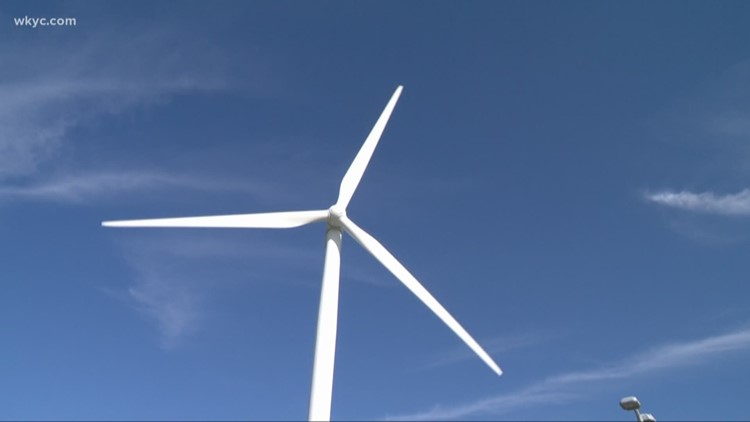COLUMBUS, Ohio — The fight over the future of wind turbines in Lake Erie near Cleveland's coastline is not over yet.
On Wednesday, a bipartisan group of 32 legislators from across Northeast Ohio sent a letter to the Ohio Power Siting Board asking it to reconsider operating restrictions placed on Icebreaker Wind. Although the board gave approval for the construction of six wind turbines in May, it contained a "shutdown condition," mandating that the turbines cease operation every night from March until November. The developers of the project, Lake Erie Energy Development Corporation (LEEDCo), say the provision makes the Icebreaker Wind project financially unfeasible.
The addition of the condition stunned both LEEDCo and advocates of the project. They believe it represented a reversal of an agreement developers reached with the state last year after the state’s own expert testified under oath the shutdown mandate was not needed.
"The efforts to justify this decision simply don’t wash," LEEDCo president Dave Karpinski said. "This dooming condition was added to the permit at the 11th hour after we spent years hammering out every detail of our operations with the OPSB Staff and the wildlife experts at ODNR. Why?"
Senators Matt Dolan (R-Chagrin Falls) and Sandra Williams (D-Cleveland), together with Representatives Jeff Crossman (D-Parma) and Dave Greenspan (R-Westlake), championed the bipartisan letter. The legislators represent a broad and diverse cross-section of Northeast Ohio from 11 counties stretching from Huron to Ashtabula, Cuyahoga to Summit, and also Geauga, Mahoning, Medina, Portage and Trumbull counties.
Together, the 32 legislators comprise almost a quarter of the entire General Assembly.
"As members of the Ohio General Assembly from Northeast Ohio, we write to object to the Ohio Power Siting Board’s recent Order in the Icebreaker case. Unfortunately, the order includes a last minute poison pill provision that upended the agreement reached among LEEDCo and the technical staffs of the Board and the Ohio Department of Natural Resources," the lawmakers wrote to Ohio Power Siting Board Chairman Sam Randazzo.
The legislators added they reviewed the facts in the case and are "puzzled" about the Board’s ruling, also calling it "unusual." They said the decision contradicted evidence presented in the case.
"If there ever was a time that Ohio needed a renewable energy project of this magnitude and with this economic impact, it’s now,’" Karpinski said. "And if there ever was a time to make sure this project passed the smell test given the unusual circumstances of the decision and the fact that fossil fuel interests were opposing our project, it is most certainly now in light of last week’s developments."
Karpinski is referencing the House Bill 6 energy scandal that erupted last week, which led to the arrest of Ohio House Speaker Larry Householder and four others following an alleged bribery scheme that led to the bailout of the state's two nuclear power plants.
LEEDCo in June asked the Siting Board to reconsider its decision, saying the OPSB stepped outside its statutory authority and violated Ohio law. They have appealed to Gov. Mike DeWine to weigh in as well.
Icebreaker Wind is projected to deliver $250 million to the Northeast Ohio local economy and create over 500 jobs. It would also serve the region’s environmental interests, delivering 20 megawatts of clean power.
The legislators gave the following reasons why the Siting Board should reconsider the order:
- The nighttime shutdown condition contradicts evidence on the record that led technical staffs at both the Siting Board and the Department of Natural Resources to approve the project without the evening shutdown mandate.
- The Order offers no compelling evidence to override the technical staffs at OPSB and ODNR’s favorable recommendation. The nighttime shutdown condition also contradicts the formal finding by the U.S. Fish and Wildlife Service that the project is low risk.
- The Order essentially requires zero impact every night for 8 months, but the statutory standard is merely “minimum” impact, considering economics and technology.
- The Order unlawfully requires two separate approvals – one for construction and a separate subsequent approval to run at nighttime. By law, the OPSB certificate, when granted, is for both constructions and operations.
The six-turbine demonstration project was planned to be eight miles off Cleveland’s shoreline. The concept was reviewed by more than a dozen state and federal agencies, including U.S. Fish and Wildlife and the Ohio EPA. It has the support of many environmental groups, including the Sierra Club, the Environmental Defense Fund, and the Ohio Environmental Council.



